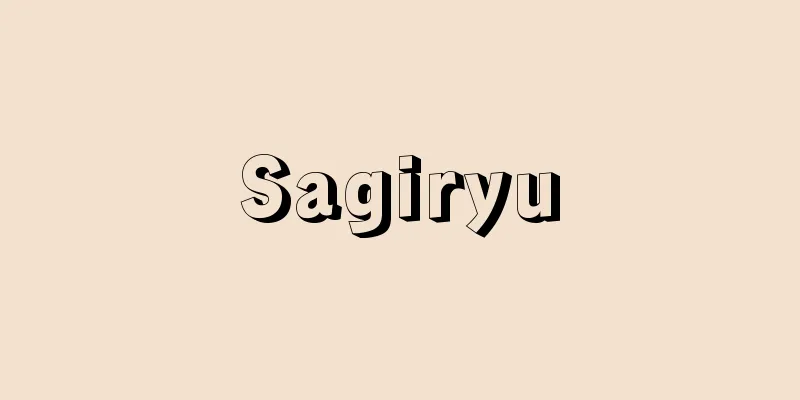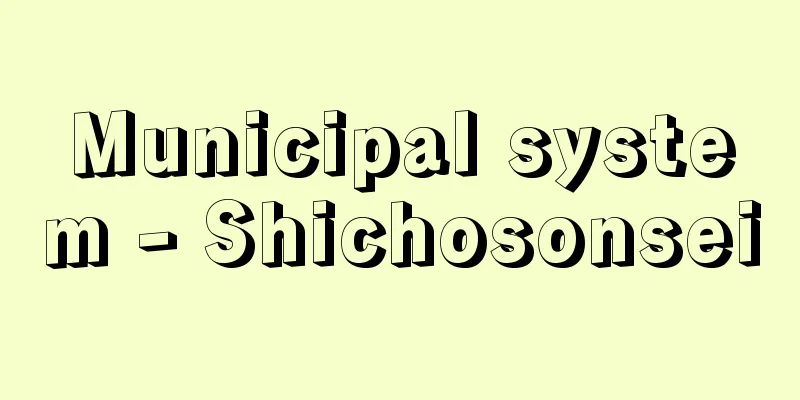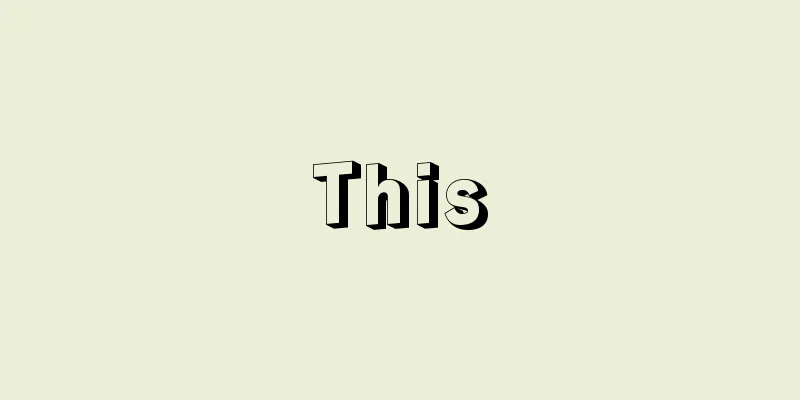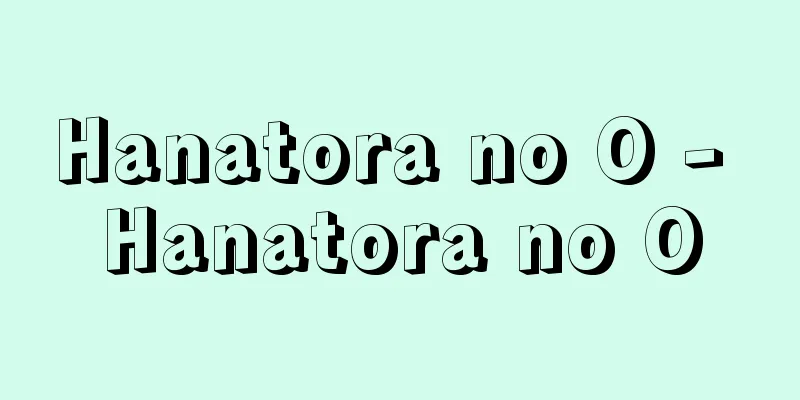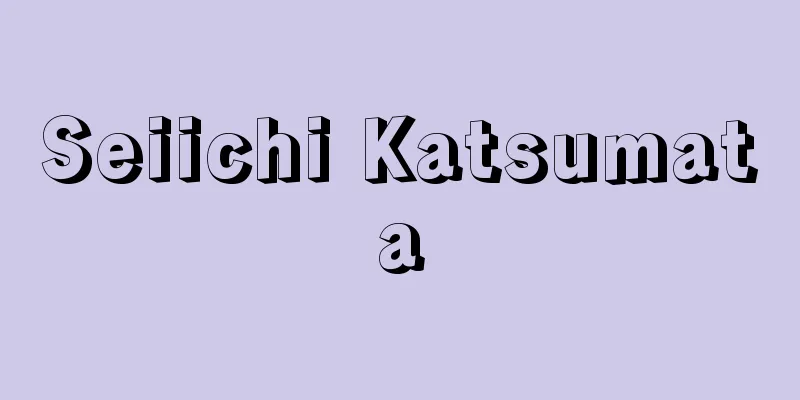Makeup - Kesho
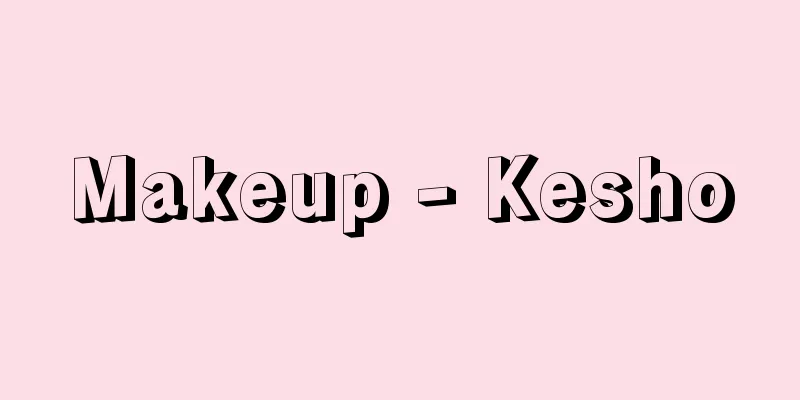
|
It mainly refers to putting on rouge or powder on the face to make oneself and others look beautiful. It has been around since the birth of mankind and is now considered an indispensable part of grooming. In other words, makeup has existed from primitive societies to civilized societies, and is at the same time a universal phenomenon that applies to all people regardless of social status. In particular, the custom of wearing extravagant makeup to appease the gods and pray for a good harvest during annual events such as special ceremonies, festivals, and farming is deeply rooted in imperial court ceremonies and private events. [Takeshi Endo] JapanFrom ancient times to the Edo periodFrom clay figurines from the Stone Age to haniwa clay figurines of people from the Kofun period, vermilion is painted on both cheeks. In the Gishiwajinden section of the Records of the Three Kingdoms, a Chinese historical text written in the 3rd century, it is written that Japanese people do this kind of makeup, which is similar to Chinese makeup, and in the myths and legends of the Nihon Shoki, as in the stories of Umihiko and Yamahiko, vermilion on the face is said to represent submission. The custom of blackening one's teeth was also practiced from early on. After the Asuka and Nara periods, imitation of Chinese customs spread rapidly, and especially in the early Heian period, the emperor issued an imperial edict calling for all cultures to imitate China. Eyebrow ink was also popular, and in China there were various styles of eyebrow painting called the Jikkenfu, and various styles of eyebrow painting were also practiced in Japan. Powder, rouge, and a washing powder called sakuzu (powdered azuki beans) were brought to Japan, and sometimes rouge was applied over powder to create a type of makeup called kosho. Moreover, Chinese-style face powders called hafuni (lead products) or haraya (mercury products) began to be produced domestically, but the Chinese-style makeup method of applying face powder not only to the face but also to the chest did not become common until the Edo period. During the Heian period, people began plucking their eyebrows and then applying makeup using eyebrow ink (called konezumi at the time). Konezumi was made by mixing blackened dayflower flowers, gold powder, and sesame oil in oil smoke. At the time, people preferred thin eyebrows that looked faintly like a crescent moon. Rouge was applied not only to the cheeks but also to the lips. Tooth blackening gradually became a ritual, and men also began to apply a thin layer of face powder. This was also a characteristic of the noble society. The samurai society of the Kamakura period valued simplicity and strength, and sought a simple appearance, but eventually came to imitate the style of the nobles, who in turn adopted the samurai style, resulting in a mixture of the customs of Kyoto and Kamakura during the Nanboku-cho period. It became popular for samurai to wear beards to show dignity, and those without beards were previously looked down upon as 'Katawazura' (a one-sided face), leading some to wear 'kakihige' (a beardless face) or 'kakehige' (a beardless face). The nobles always lived within rules, which gave rise to a custom known as 'Yusoku' (a court nobleman), and there was even a family that was in charge of this custom. After the decline of the power of the nobility, the samurai took control of the country, but following the example of the nobility, a certain etiquette was established among the samurai as well. This was called Kojitsu, and schools such as Imagawa, Ise, and Ogasawara were established. In other words, rules from martial arts were carried out into the life of the samurai. In the Muromachi period, the custom of blackening one's teeth became one of the ceremonies performed at the age of nine. Meanwhile, eyebrow shaping moved from the samurai to the general public, where thick powder was applied, and nose powder that made the nose look higher was considered ugly. From the end of the Momoyama period, it became custom to shave the forehead, i.e. the hairline, and face powder was produced following the Chinese manufacturing method, with Zeniya Oshiroi by Zeniya Soan and Konishi Oshiroi, invented by Konishi Seibei, a drug store owner in Sakai, Osaka, being sold. Not only did women of noble rank apply rouge to their cheeks and lips, but women of noble rank also began to apply rouge to their nails, a practice known as tsumabeni. Heavy makeup was a traditional style among noble women, but from the time of the third shogun, Iemitsu, in the Edo period, heavy makeup was considered vulgar among courtesans, and light makeup became fashionable. This spread to ordinary women, and as part of a woman's grooming, it became customary to apply rouge all over, under the ears, on the throat, and even on the chest. Around this time, hairstyles became more complicated as the custom of putting a topknot on top of the head was adopted. Accordingly, the way the forehead was shaped also changed from simply shaving the hairline to the large forehead, small forehead, katoguchi, suriage, and other styles. Katoguchi is also written as kawaratoguchi, and later became the Fuji forehead. Thick eyebrows were considered vulgar, and thin ones like uguisumayu (nightingale eyebrows) were preferred, and freshly drawn eyebrows were popular among children. During the Genroku period (1688-1704), ohaguro (blackened teeth) and seitai (eyebrow ink) became part of the rites of passage associated with women's coming-of-age ceremonies and weddings. Not only that, as the times of peace continued, townspeople who had more leisurely lives began to enjoy sightseeing, and so they spent more time on makeup. To promote their own products, the industry began to use the speeches and promotions of Kabuki actors. In the late Edo period, a big difference emerged in makeup between Edo and Kamigata, with Kamigata heavy makeup and Edo light makeup, with Edo makeup being described as faintly fragrant white plum blossom makeup and Kamigata makeup being gaudy and decorative makeup. Kabuki actors started using nose makeup to make the nose look higher, and it was also adopted by townspeople. Lipstick was applied thickly to the lower lip to give it an iridescent glow, which was called Sasairo-robe, but to make it cheaper, ink was applied as a base for the lips and then rouge was applied on top. Mixing Japanese bush warbler droppings as a face wash was also a makeup technique that began around this time. "Edo water," "Kyoto water," and "flower dew" were used as makeup bases, and loofah water was also widely used. Booklets such as "Miyako Fuzoku Makeup Den" and "Yogan Bienko" were published as books on women's grooming. [Takeshi Endo] After the Meiji PeriodIn the early Meiji period, makeup was a direct continuation of the Edo period. In 1883 (Meiji 16), the Rokumeikan was built as a social gathering place for the upper class, and although a policy of Westernization was implemented, Japanese makeup was still dominated by face powder, and other makeup such as rouge, eyebrow ink, hair oil, and washing powder were also commonly used. In the middle period, washing the face with soap gradually became more popular, and as lotions, creams, perfumes, and powder face powders for light and finished makeup and water face powders were released, interest shifted to natural beauty, and skin-colored and yellow face powders began to appear in face powders, which had previously only been white. Water face powder was also widely used. And at the end of the Meiji period, something similar to today's facial beauty techniques (facial massage) began to be practiced. In general, this period can be called the "era of face powder makeup." In the Taisho period, milky lotion (face lotion) was made to replace face powder, and Western-style cosmetics such as lipstick, blusher, nail polish, and eyebrow pencil were developed. Mascara and eyeshadow makeup was also seen, but it was limited to some parts of the city. At the end of the Taisho period, waves made by ironing technology were imported, and this was probably due to the influence of hair cutting and dyeing. In the early Showa period, Shiseido released cream face powder, which gained a reputation as a quick and easy way to apply makeup. This was in the 1930s. From the Taisho period to the early Showa period, the era of face powder was over and the era of cream and lotion makeup was ushered in. Around this time, American beauty techniques were introduced in detail, and nail polish and face packs began to be tried. Individualistic beauty makeup was advocated, and mannequin girls appeared to demonstrate the techniques. In 1937 (Showa 12), the Second Sino-Japanese War broke out, and the military atmosphere became stronger, permanent hair was eliminated, and flashy makeup was discouraged. In 1941, the Pacific War began, and clothing was changed to a single color similar to military uniforms, called the national defense color, and monpe pants were worn. Not only male students but also female students were mobilized to work in munitions factories, and lipstick was sometimes rationed as a grooming item. In 1945 (Showa 20), Japan lost the war. The American trend was reflected in makeup, and instead of the prewar method of using vanishing cream as a base, cold cream was used. There was a period when this was called "shining makeup" along with crimson lipstick. The postwar recovery could be said to have begun with a reinforcing of makeup, which had been suppressed until then. Then, the production of oil-based cream foundations and three-dimensional makeup using three-colored powders led to a shift from yellowish skin tones to pink, and blush gradually disappeared. Towards the end of the 1950s, lipstick was added to these changes in makeup. The color of dark lipstick changed to pink, and the colors diversified from coffee to wine, dark brown, blue, green, and even to a color close to black. At the same time, eye makeup using eyeliner also began to be used little by little, and from the 1960s, eye makeup escalated with the passage of time, with mascara, eyeliner, eyeshadow, false eyelashes, and painted eyelashes. On the other hand, powders have also moved away from the conventional notion of skin color, white paint, and thick application, and instead become more popular, with highly transparent powders bringing out the natural beauty of the skin and the foundation. The rise in interest in makeup is undoubtedly largely due to the spread of color television. The accents on makeup seen on television each year are correlated with trends in hairstyles and fashion, and are becoming more diverse as personal life expands (including leisure). This can be characterized as the "era of three-dimensional makeup." From the 1970s to the 1980s, there was a clear indication of an increase in the population wearing makeup (both older and younger, and it was also becoming more common among some men). [Fumisako Yokota] WesternAncientThe words makeup and cosmetics are usually named according to the makeup methods of the time. The word makeup, as it is commonly used today, is said to have been first used by the English poet Richard Crashaw in the early 17th century, and meant the elaborate makeup worn by women at that time. In French, it is called maquillage, which was originally a theatrical term meaning disguise. Prior to this, Shakespeare used the word painting, which was a popular term at the time. Initially, this also referred to the heavy makeup introduced from Italy in the 16th century, but throughout the 16th and 17th centuries, face powder made from white lead was called paint, and later the term painting came to mean not only face powder but also the application of color with various pigments. On the other hand, the French word toilette was introduced to England around 1540 and became toilet, and it means not only makeup but also any outfit in general. The word dressing also includes the meaning of makeup in a broad sense. It is said that "makeup is clothing that can be washed off," and clothing and makeup as accessories are essentially the same. Therefore, makeup originated in ancient times, and each era had its own unique style of application. In ancient Egypt, makeup was already a universal custom that transcended class and gender. Their makeup was characterized by a base of ochre or orange skin tones, with green, black, or gray eyeliner and green, blue, black, and various brown eyeshadows to emphasize the eyes. Furthermore, in Egypt, people would dye their nails, palms, and soles of their feet red-orange with henna, and sometimes they would paint their nipples gold. In ancient Greece, cosmetics developed significantly through exchanges with the East. Both men and women preferred blonde hair, sprinkled powder on their hair, and used plenty of perfume. Toothpaste was also invented. People preferred to draw long eyebrows with a narrow curve between the eyebrows, and some women used false eyebrows. Etruscan women also narrowed their eyebrows, applied eyeliner, and used rouge and lipstick. In Rome, whitening the skin became the basis of makeup, and bathing became a common practice. Powders made from white lead or chalk, as well as bleach and hair dyes, were the main products, and perfumes were used in excess. False eyelashes, false eyebrows, dentures, and wigs were also important makeup accessories. [Hirano Yuko] middle agesMedieval makeup did not develop significantly, but the Roman tradition was carried over to Byzantium and Italy, and it developed greatly in the Islamic world. In Arabia, people wore veils to keep their faces white, and they took steam baths, dyed their hair, removed hair, had manicures, and massaged their faces. They also knew how to use sophisticated cosmetics. Women of the bourgeoisie spent time in hammams (Turkish baths) to become beautiful. This was the beginning of beauty salons, so to speak. In Byzantium, wigs and masks were used, and women had thin, black eyebrows and pink cheeks and lips, creating techniques and styles that matched their gorgeous costumes. Even throughout the Middle Ages, women, without exception, wanted to look white. White and pink water-soluble pigments were used, rose-colored lipstick in Spain, orange-colored lipstick in Germany and England, and crimson lipstick in France, and full, thick lips were preferred. Eyeshadows of various colors, including green, blue, gray, brown, and purple, were also used, with the French favoring sky blue and the British favoring gray. Eyebrows were naturally shaped until around the 14th century, but after the Gothic period, thin eyebrows became more popular, and people drew their eyebrows thin by plucking the hairline and eyebrows. After the Renaissance, in the 15th century, ancient makeup techniques were revived, mainly in northern Italy. A wide, white, ivory-like shining forehead, thin eyebrows, and small lips were preferred, and sensual physical beauty was praised. Powders and perfumes were used not only on the face, but also on the neck, chest, and whole body. Bathing in water was common in Spain, but bathing became rare after the Middle Ages, and perfume became more and more important. At the end of the 16th century, eyebrows returned to their natural thickness, and false moles (patches, beauty spots, or mouches) began to be worn. False moles were a custom that had also been practiced in ancient Rome. In France and England, blonde hair was popular, and sometimes men also openly wore makeup and used perfume in the same way as women. The 17th century is also known as the age of false moles and patches. Patches cut into all shapes and sizes were pasted all over the face, and the custom extended to the elderly and clergy. In the second half of the 17th century, oval faces began to become fashionable, replacing fuller, rounder faces. Powder, lipstick, hair powder, false moles, and patches were used by people of all ages and genders. [Hirano Yuko] 18th centuryThe 18th century, known as the century of women, saw the heyday of hairdressers and beauticians, and as a great deal of cosmetics were consumed, advertisements for cosmetics began to appear. Hairstyles and makeup became more and more technical, and the use of rouge in particular was unique. Rouge was applied in a circular pattern on cold, white cheeks, and it was worn all day long, ranging from deep, vivid red to pale red. White powder was sprinkled on thick hair, and in addition to false moles, veins were also painted pale blue on the skin to make the skin look even whiter. All fashions spread from the court to the citizens, and eventually to all countries. However, these standards began to collapse around the time of the French Revolution. Naturalism and English taste in the late 18th century transformed excessive decoration into simplicity overnight. The return to natural makeup was probably due to the personal influence of Marie Antoinette. Bright red rouge went out of fashion, and soft floral scents became popular instead of harsh perfumes. The French Revolution banned filthy heavy makeup and wigs and revived the sense of cleanliness that had existed since ancient Rome. [Hirano Yuko] 19th century and laterIn the 19th century, perfume was still popular, but hygiene became more important, and scented soap became popular. Meanwhile, Napoleon III made eau de cologne popular. Gaudy makeup that "painted the face" went out of fashion, and until the 1950s, makeup that "colored the face" was limited to the world of theater and film, and the term "painted woman" even became a synonym for a woman who was not very common. In the Victorian era in the second half of the 19th century, romantic makeup with pale complexions, large moist eyes, and neat, naturally flowing hair was popular, and sentimental ladies with delicate, slender waists were preferred. However, from the end of the 19th century to the 20th century, along with the development of natural science, the manufacturing technology of cosmetics also showed remarkable progress. At the same time, calls for social liberation of women, sports became popular, and clothing became simpler. Cosmetics became popular and mass-produced, and new types of makeup appeared along with the simplicity of clothing. These included various beauty methods for losing weight, the popularity of brightly painted lips that arose from lipstick, the popularity of tanned skin due to the appearance of swimsuits, and the popularity of manicures and pedicures since the 1930s. The Second World War greatly increased the number of working women at all levels, and cosmetics became increasingly popular, and simple makeup methods became popular. However, today, not all technological improvements have been completed, and it is questionable how much progress has been made in the essential aspects compared to the remarkable progress in other science and technology. Moreover, the harm of makeup and cosmetics is still debated. It can be said that the characteristic of today's makeup is the development of new types of cosmetics that protect the skin. As a result of precise skin analysis, safer, more personalized cosmetics are manufactured to suit the diverse characteristics of different skin types and individual needs. Fashion has always inspired people's dreams, just as it has in the past and today, but just as we cannot expect any major changes in the flesh and blood of humans, whether it be in clothing or makeup, it can be said that it all comes down to how we change and satisfy decoration, which reflects the human heart. [Hirano Yuko] Customs of the WorldIf we broadly define makeup as any modification of body parts that humans are born with, it can be said that no human society has ever used makeup since the dawn of history. Although there is no definite proof of when makeup first appeared, the appearance of accessories that are thought to have a similar function to makeup for humans was confirmed in the Aurignacian period of the Paleolithic Age, and are presumed to have already existed around the time of the Third and Fourth Ice Ages. Therefore, makeup is presumed to have developed significantly at the latest around the end of the Mesolithic Age, when agriculture and livestock farming emerged and human life became stable. The initial purpose of makeup was practical, as seen in the Ona people who lived in Patagonia, South America, who applied thick layers of animal fat to their bodies to survive the bitter cold, and the origin of eye shadow, which was developed in ancient Egypt, is said to have been to protect the eyes from poisonous insects and eye diseases. At the same time, we cannot ignore the purpose of satisfying the aesthetic desires that humans have instinctively and increasing sexual attractiveness. Furthermore, makeup appears to have also emerged at almost the same time as a kind of religious talisman, a magical or religious act to ward off illness or harm, or to bring good fortune. Makeup also has an ambiguous function, in that it distinguishes an individual from a group, while also indicating which group an individual belongs to. One example is the extremely common case, not only in Africa, where a person's tattoos indicate their tribe. The group indicated can include not only the tribe of origin, but also class, sex, marital status, occupation, etc. Examples are blackened teeth and front hair in Japan. In addition, makeup can also be used to realize a longing for something exotic or different. It can be said that the act of Sekel San women in Angola imitating the hairstyle of powerful neighboring Bantu tribes and the act of Asian women bleaching their hair are on the same line. Furthermore, makeup used during festivals or battles indicates that the group or individual is facing an abnormal situation. Needless to say, the various functions of cosmetics mentioned above do not only exist individually, but often exist in a mixture. Makeup in primitive societies is characterized by the fact that it is often what is called body modification in cultural anthropology. Body modification is a type of body decoration in the broad sense, and involves surgical procedures on the body, such as head compression as seen among the Tutsi in Africa, lip elongation using discs among the Suya in South America, and neck elongation using collars among the Padaung in Burma (Myanmar). However, even in modern civilized societies, earlobe piercing and tattooing are not uncommon, and foot binding also existed even after the establishment of the Republic of China. Therefore, the most distinctive feature is that men, rather than women, wear flashy makeup, as is typically seen in the Maasai in Africa and the Kamayura in South America. It can be assumed that modern societies, in which women are more interested in makeup than men, are rather an exception in the long history of humanity. Another characteristic is that among the Banda people of Africa, mothers of deceased children tend to wear makeup that has a strong religious or magical element, as shown by the example of the mother applying white clay to her face to indicate that white is the color that signifies death. The parts of the human body that are applied with makeup can be broadly divided into skin (face, neck, head, limbs, chest, lower back), mucous membranes (lips, external genitalia), hair (head hair, beard, pubic hair, eyebrows, eyelashes), teeth and nails, etc. The methods of application include coloring (white, black, red, blue, yellow, purple, brown pigments, gold and silver powder, mica powder, shell powder) and adding luster (fruit juice, wool, oil, clay, talc powder). As for the colors of makeup, each color often has a symbolic meaning. As mentioned above, white generally represents death. During the coming-of-age ceremony, a rite of passage for boys of the Ngangela people of Africa, they paint their faces and bodies white, which is understood to represent a state of suspended animation on the border between boyhood and adulthood. Another example is that red represents life and is said to expel evil. [Takemi Riko] FolkloreMakeup refers to the application of rouge or white powder to the face and other parts of the body to decorate it, but it also included changing the appearance of the face by dyeing teeth black, shaving eyebrows, etc. In Japan, it was written as kasou or kasou, and meant dressing up in a way that was different from one's normal self. In archaic Japanese, it was called "kehahi," and makeup was about creating an extraordinary atmosphere. Having a face that is different from the everyday one represents the possession of a divine spirit, and has the same effect as wearing a mask. It is no exaggeration to say that the magical element of makeup has existed since the beginning of human cultural history. Even today, some ethnic groups apply red or white clay to their faces and bodies during rituals to show a different state from their everyday lives. In China, women who wear beautiful makeup are described as looking like goddesses, and in Japan, women who participate in divine festivals always wear makeup and are distinguished from ordinary women. Even today, there are examples of boys dressing up as women and applying red or white powder to festivals in various places. Every year, at the annual festival of Mount Iwaki in Aomori Prefecture on the first day of the eighth month of the lunar calendar, 14- or 15-year-old boys visit the mountain wearing white robes and carrying a sacred offering, then, after descending the mountain, they apply red or white powder to their faces, dress up, and dance as they please. This signifies their participation in the coming-of-age ceremony, and the makeup indicates the emergence of a new adult, not the boy they were before, and expresses the protection of the divine spirits. Also, during the rice planting season in May, the young maidens always wear makeup, not just because the makeup is beautiful, but because they are holy maidens taking part in the most sacred agricultural event of the rice planting ritual. There are place names such as Kehai-ta and Kehai-zaka in various regions, and many of these places have legends related to traveling shrine maidens. Again, this is because makeup was not originally something that anyone could do, but was only permitted to be worn by those who worshiped the gods, and so these unusual place names have been passed down in legend. Makeup, which was previously only worn on formal occasions, gradually became part of everyday life for women today, as people found it beautiful and desired to recreate it on an everyday basis. Cosmetic tools are also used in religious ceremonies in various places, which indicates that makeup was originally a sign of the descent of the gods. The most common colors of makeup are red and white, with red being prized as a color with magical powers, and it was believed that applying it to the body would protect the wearer. The widespread use of makeup signifies the universalization of the spiritual power of the women who wear it, that is, a change in the social status of women. [Kamata Hisako] "The History of Make-up: The Flow of Western Cosmetic Culture" (1982) by Richard Corson, supervised by Akira Ishiyama, translated and published by the Pola Cultural Research Institute" ▽ "The History of Beauty" by Jacques Pensée and Yvingle Delandre, translated by Noriko Aoyama (Hakusuisha, Quessais-je Bunko) ▽ "The Cultural History of Fashion" by Yukio Haruyama (1976, Heibonsha) ▽ "Makeup" by Tsukasa Kuge (1970, Hosei University Press) ▽ "Maggie Angeloglou: A history of make-up (1970, Studio Vista, London)" [Reference] |Source: Shogakukan Encyclopedia Nipponica About Encyclopedia Nipponica Information | Legend |
|
主として顔に紅をつけたり、おしろいをつけて装い、自分および他人に美しく見せることをいう。人類の誕生以来のもので、現在では身だしなみとして欠くことのできないものとされる。つまり化粧は、未開社会から始まって文明社会に及ぶものであり、同時に世界共通の事象であり、身分の上下のない普遍的な事柄でもある。ことに晴の儀式や祭礼、耕作などの年中行事のおりには、ひときわあでやかな化粧をして、神の心を和らげ、豊年を祈念する風習は、宮中の盛儀や民間の行事として根強く存在している。 [遠藤 武] 日本古代から江戸時代石器時代の土偶をはじめとして、古墳時代の人物埴輪(はにわ)では、左右の頬(ほお)に朱を塗っている。3世紀に書かれた中国の史書『三国志』の「魏志倭人伝(ぎしわじんでん)」のなかに、日本人がこのようなことをするのは中国の化粧のようであると記し、『日本書紀』の神話伝説のなかでは、海彦(うみひこ)・山彦(やまひこ)の話にもあるように、顔に朱をつけるのは服従の意味を表すものとしている。歯を黒くするお歯黒の風習も、早くから行われていた。飛鳥(あすか)・奈良時代以降、中国の模倣が急速に広まり、とくに平安時代初期には、天皇も詔勅を出して、あらゆる文化は中国に倣えというほどであった。眉墨(まゆずみ)を引くということも盛んに行われ、中国には十眉風(じっけんふう)というさまざまの眉引が行われていたが、わが国でもいろいろの眉引が行われた。おしろい、紅、澡豆(さくず)(粉末状にした小豆(あずき))という洗い粉がもたらされ、おしろいをつけた上から紅を塗る紅粧(こうしょう)ということもあった。 そればかりかハフニ(鉛製品)あるいはハラヤ(水銀製品)という中国風の白粉(おしろい)が国産されるようになったが、おしろいを顔ばかりでなく胸にまで塗る中国風の化粧法は、ついに江戸時代まで行われなかった。平安時代から眉毛を抜いて、そのあとに眉墨(当時これをこねずみといった)で化粧することが始まった。こねずみは、油煙の中に、ツユクサの花を黒焼きしたものと、金粉とごま油を混ぜて練り上げたものである。当時は、三日月のように、ほのかに見える細い眉を好んだ。紅は頬ばかりでなく、唇(くちびる)にもつけるようになった。お歯黒はしだいに儀式化する傾向が現れ、またおしろいは男性の間にも薄くつけることが行われ始めた。これがまた公家(くげ)社会の特色でもあった。 鎌倉時代の武家社会は、質実剛健を尊び、簡素な姿を旨としたが、やがて公家風をまねるようになり、これとは反対に公家が武家風を取り入れることもあって、南北朝時代には、京と鎌倉の風俗が混合した。武士が威厳を表すために、ひげをたくわえることがはやり、ひげをたくわえない者を片輪面(かたわづら)といって卑しんだところから「かきひげ」や「かけひげ」をする者もあった。公家はつねに決まりのなかに生活していたところから有職(ゆうそく)というしきたりが生まれ、それをつかさどる家柄さえあった。 公家勢力の衰退後、武家が国家の支配権を握ったが、公家に倣い武家の間にも一つの作法ができた。これを故実(こじつ)といい、今川、伊勢(いせ)、小笠原(おがさわら)などの流派ができた。つまり武道における決まりが武家生活のなかにまで行われるようになった。お歯黒の風習は室町時代になると9歳のときの儀礼の一つとなった。一方、眉作りは武家から民間へも移り、おしろいを濃く塗ることが行われ、鼻を高くみせる鼻おしろいをするのは醜いものとされていた。 桃山時代の終わりごろより、額つまり生え際を剃(そ)ることが行われ、おしろいは中国における製法に倣って、銭屋宗安の銭屋おしろい、大坂・堺(さかい)の薬種屋小西清兵衛発案の小西おしろいが売り出された。紅は頬、唇ばかりでなく、爪紅(つまべに)といって爪(つめ)に紅を塗ることが高貴の女性の間で行われるようになった。高貴の女性の間では昔ながらの厚化粧であったが、江戸時代に入って3代将軍家光(いえみつ)のころから、遊女たちの間では厚化粧は卑しいものとされ、薄化粧が流行を始めた。これが一般の女性の間にも行われ、女の身だしなみとして、耳の下、のど、胸まで残らず塗るようになった。 このころになると、頭上に髷(まげ)を置く結髪の風習が行われたために、髪形も複雑化した。それにつれて額のつくり方も、生え際を剃るばかりでなく、大額(おおびたい)、小額、火塔口(かとうぐち)、すりあげなどができた。火塔口は瓦燈口とも書き、後の富士額のことである。眉は太いのは卑しいものとされて、鶯眉(うぐいすまゆ)のような細いものが喜ばれ、子供にはきしたて眉が喜ばれた。元禄(げんろく)時代(1688~1704)には、お歯黒と青黛(せいたい)(眉墨)は、女の元服や婚礼との結び付きで通過儀礼の一つとなった。そればかりでなく、太平の世が続き、生活にゆとりのできた町人たちの間では物見遊山が盛んとなり、このための化粧にかける時間も多くなり、業界では自家製品を広めるために歌舞伎(かぶき)役者の口上、おひろめなどを利用した。 江戸後期には、江戸と上方(かみがた)では化粧面でも大きな差が生まれ、上方の厚化粧、江戸の薄化粧といわれ、ひいては、ほんのりと薫る白梅を江戸化粧、あでやかに飾る化粧を上方の化粧とした。歌舞伎役者の間から、鼻を高く見せる鼻化粧が行われて、町人の間にも取り入れられた。口紅は、下唇に濃く重ね塗りをして玉虫色に光らせたのを笹色(ささいろ)紅といったが、安価に行うには、唇の下地に墨を塗ってその上に紅をつけた。洗顔にウグイスの糞(ふん)を混ぜて用いることも、このころから始まった化粧法である。化粧下として「江戸の水」「京の水」「花の露」が用いられ、ヘチマの水も広く愛用された。女の身だしなみの本として『都風俗化粧伝』とか『容顔美艶考(ようがんびえんこう)』という冊子も刊行された。 [遠藤 武] 明治以降明治時代前期では、江戸時代の化粧をそのまま受け継いだといってよい。1883年(明治16)上流社会の社交場として鹿鳴館(ろくめいかん)が建設され、西欧化の政策がとられたとはいえ、まだおしろい全盛の和風化粧で、そのほかに、紅、眉墨、髪油、洗い粉などが普通に使われていた。中期に入り、せっけんでの洗顔がすこしずつ普及し始め、化粧水、クリーム、香水や、薄化粧用、仕上げ化粧用の粉おしろい、水おしろいなどが発売されると、自然な感じの美しさに関心が向けられ、それまで白1色であったおしろいにも、肌色や黄色などが現れるようになった。水おしろいも盛んに使われた。そして現在の美顔術(フェイシャル・マッサージ)に近いものが、明治末期には行われ始めた。概してこの時代は「おしろい化粧時代」といえよう。 大正に入ると、おしろいにかわって乳白化粧水(化粧液)がつくられ、口紅、頬紅、マニキュア、眉墨など、それまでとは違った洋風の化粧品が開発された。マスカラやアイシャドーを使った化粧もみられたが、都会の一部に限られていた。大正末期には、アイロン技術によるウェーブが輸入されたり、断髪、毛染めなどの影響からであろう。 昭和初期には、資生堂からクリームおしろいが出て、手早く仕上げのできるスピード化粧と評判になった。1930年代のことである。大正から昭和初期にかけて、おしろい時代から脱した「クリーム・化粧水化粧時代」を迎える。このころ、アメリカの美容法も具体的に紹介され、マニキュア、パックなどが試みられるようになった。個性美化粧が唱えられ、化粧法のためのマネキン・ガールが登場した。1937年(昭和12)日中戦争が勃発(ぼっぱつ)、軍事色が強まり、髪形からパーマネント追放、はでな化粧の自粛。41年太平洋戦争突入、服装も国防色といわれる軍服に似た色1色、もんぺ着用、男子生徒・学生ばかりでなく、女学生の軍需工場への動員などの事態を迎えたが、身だしなみとして口紅だけは配給されていたこともあった。 1945年(昭和20)敗戦。アメリカの風潮がそのまま化粧にも表れ、戦前からのバニシングクリームを化粧下に使う化粧法から、コールドクリームを使うようになり、真紅の口紅の化粧とともに「光る化粧」といわれる時期があった。戦後の復興は、それまで抑えられていた化粧から始まったともいえる。そして油性クリームファンデーションの製造、3色のおしろいを使っての立体化粧など、黄みを帯びた肌色からピンク系に移っていき、しだいに頬紅は使われなくなった。1950年代終わりごろには、そうした化粧の変化に、さらに口紅が加わった。濃いめの口紅の色がピンクに、コーヒー色からワイン系、ダークブラウン、ブルーやグリーン、黒に近い色にまで多彩化した。同時に、アイラインを入れるアイメーキャップもすこしずつ行われ始め、60年代からは、マスカラ、アイライナー、アイシャドー、つけまつげ、描きまつげなどと年代を追うにつれ、目の化粧はエスカレートしていった。 一方、おしろいも、いわゆる肌色や、白く塗る、厚く塗るという、いままでの観念から脱皮して、素肌美を生かす、下地を生かすために、透明度の高いパウダーが愛用されるようになった。 こうした化粧への関心の高まりには、なんといってもカラーテレビの普及が大きくかかわっている。テレビを通じてのその年々の化粧のアクセントは、ヘアスタイル、モードなどの流行と相関関係を保ちながら、また個人生活の広がり(レジャーを含む)につれて、多様化しているのが現状である。特徴的には「立体化粧の時代」といえよう。1970年代から80年代にかけては、化粧人口の増大(高年齢化と一方で低年齢化を含め、また一部男性の間にも普及しつつある)が、はっきり示されてきている。 [横田富佐子] 西洋古代化粧、化粧品の語は、その時代の化粧法を反映してよばれるのが普通である。今日一般に用いられるメイクアップ(メーキャップ)make-upの語は、17世紀初頭、イギリスの詩人リチャード・クラショーが最初に使ったといわれ、当時の女性の念入りな化粧を意味した。フランス語ではマキャージュmaquillageであり、もともとこの語は扮装(ふんそう)を意味する演劇用語であった。これより以前、シェークスピアは、当時の流行語であったペインティングpaintingの語を用いている。当初これも、16世紀にイタリアから伝来した厚化粧をさしたが、16、17世紀を通して鉛白を原料とするおしろいはペイントとよばれ、のちにはおしろいに限らず多彩な顔料で色を塗ることをペインティングとよぶようになった。一方、フランス語のトアレットtoiletteは、1540年ごろイギリスに伝わりトイレットtoiletとなった語で、化粧のほかに装い全般を意味する。またドレッシングdressingの語も広義には化粧の意が含まれる。「化粧は洗い落とせる衣服」ともいわれ、装身としての衣服と化粧は本質的に同一であると考えられる。したがって化粧の始まりはたいへんに古く、各時代はその仕方について特有の型をもっていた。 古代エジプトでは、化粧はすでに階級、性別を超えた普遍的な風習であった。黄土色やオレンジ色の肌色をベースに、緑、黒、灰色のアイラインと、緑、青、黒そして多様な茶色のアイシャドーで目を強調するのが彼らの化粧の特徴である。さらにエジプトでは、爪(つめ)や手のひら、足の裏をヘンナ(指甲花)で赤橙(せきとう)色に染めたり、ときには乳首を金色に塗ることもあった。古代ギリシアでは、東方との交流によって化粧品は著しく発展した。男女ともにブロンドの髪を好み髪粉を振りかけ、ふんだんに香料を使った。また歯みがき粉も発明されている。眉間(みけん)を狭くカーブした長い眉(まゆ)を描くのが好まれ、つけ眉毛を使う女性もいた。エトルリアの女性も眉間を狭くしてアイラインを入れ、頬紅(ほおべに)と口紅を使っている。ローマになると、肌を白くすることが化粧の基本となり、入浴が盛んに行われた。鉛白やチョークのおしろいをはじめ、漂白剤や染毛剤などが中心になり、とりわけ香料は過度に使われた。つけまつげ、つけ眉毛、入れ歯、かつらも重要な化粧の小道具であった。 [平野裕子] 中世中世の化粧には格別の進展はみられなかったが、ローマの伝統はわずかにビザンティンとイタリアに引き継がれ、むしろイスラムの世界で大きく進展する。アラビアでは顔の白さを保つためにベールをかぶったし、蒸し風呂(ぶろ)、染毛、脱毛、マニキュア、マッサージなどが行われ、洗練された化粧品の使い方も知っていた。有産階級の婦人は美しくなるため、ハンマム(トルコ風の浴場)で時を過ごした。いわば美容院の始まりである。ビザンティンでは、かつらやマスクも使われ、黒く細い眉に頬と唇(くちびる)はバラ色に染めて、その華麗な衣装にふさわしい技巧と様式をつくりあげた。中世を通じても、女性は例外なく白く見られるよう望んでいたらしい。白やピンクの水溶性顔料に、スペインではローズ系の口紅が、ドイツやイギリスではオレンジ系、フランスでは深紅の口紅色が用いられ、ふっくらと厚い唇が好まれた。緑、青、灰色、茶、紫など多彩な色のアイシャドーも用いられ、フランス人は空色、イギリス人は灰色を好んだという。眉は14世紀ごろまでは自然な形であったが、ゴシック期以後、細い眉への賞賛が高まり、額の生え際や眉毛を抜いて細く眉を描いた。 ルネサンス以後15世紀には、北イタリアを中心に古代の化粧法が復活する。象牙(ぞうげ)のように輝く白く広い額、細い眉、小さな唇が好まれ、官能的肉体美がたたえられた。顔ばかりでなく、おしろいや香料は首、胸あるいは全身に使った。スペインでは水浴がよく行われたが、中世以降には入浴はまれになり、香水はますます重視されるようになる。16世紀末になると眉は自然の太さに戻り、付けぼくろ(パッチ、ビューティ・スポットあるいはムーシュ)がつけられるようになった。付けぼくろは、かつての古代ローマでも行われていた風習である。フランスやイギリスではブロンドの髪がもてはやされ、ときにより男性も公然と化粧を行い、香水も女性同様に使用した。17世紀は、付けぼくろとパッチの時代ともいわれている。あらゆる形や大きさに切り抜かれたパッチが顔中に貼(は)り付けられ、その習慣は老人から聖職者の間にまで及んだ。17世紀後半になると、ふっくらした丸顔にかわって卵形の顔が流行し始める。おしろい、口紅、髪粉、付けぼくろ、パッチは、年齢、性別にかかわりなく用いられた。 [平野裕子] 18世紀女性の世紀といわれた18世紀は、結髪師や美容師が全盛を誇り、おびただしい化粧品が消費されるにつれて、化粧品の広告が現れてくる。髪形も化粧もますます技巧的になり、とりわけ頬紅の使い方は独特のものであった。冷たく白い頬の上に丸く塗った頬紅、しかも濃い鮮やかな紅から淡い色の紅まで、頬紅は一日中塗られていた。うず高い髪には白い髪粉が振りまかれ、肌をいっそう白く見せるため、付けぼくろのほかに、皮膚の上に淡く青色で血管を描いたりもした。すべての流行は宮廷から市民へ、そしてやがてはあらゆる国々へと広がっていった。しかしこうした基準はフランス革命前後から大きく崩れてくる。18世紀後半の自然主義とイギリス趣味が、過剰な装飾を一夜にして単純なものに変えてしまうからである。化粧の自然への復帰は、おそらくはマリ・アントアネットの個人的な影響によるものと思われる。真っ赤な頬紅は廃れ、どぎつい香料にかわって柔らかい花の香りを流行させた。フランス革命は不潔な厚化粧やかつらを追放し、古代ローマ以来の清潔感をよみがえらせた。 [平野裕子] 19世紀以降19世紀になって、香水は依然として愛用されていたが、衛生面がより重視されるようになり、匂(にお)いをつけたせっけんが流行する。一方、ナポレオン3世はオーデコロンを流行させた。「顔に色を塗る」けばけばしい化粧はもはや流行おくれとなり、後の1950年代まで、「顔を彩る」化粧は演劇や映画の世界に限られ、顔を彩った女(ペインテッド・ウーマン)ということばは、あまり一般的ではない女性の代名詞にさえなった。19世紀後半のビクトリア王朝時代になると、青白い顔色に、潤んだ大きな目、自然に流した清楚(せいそ)な髪といったロマンチックな化粧が行われ、可憐(かれん)な細腰の、センチメンタルな淑女らしさが好まれた。 しかし19世紀末から20世紀にかけては、自然科学の発達とともに、化粧品の製造技術も著しい進歩をみせる。女性の社会的解放が叫ばれ、スポーツが流行し、衣服が単純化されてゆくのも、それと並行してであった。化粧品は大衆化し、量産され、衣服の簡潔さに伴って新しい型の化粧が現れた。やせるためのさまざまな美容法、棒口紅(リップスティック)から生まれた鮮やかに描かれた唇の流行、海水着の出現による日焼けした肌の流行、そして1930年以来のマニキュア、ペディキュアの流行などである。第二次世界大戦は、あらゆる階層にわたって働く女性を大幅に増やし、化粧品はますます大衆化され、簡便な化粧法が好まれるようになった。だが今日、技術的な面での改良がすべて終わったわけではなく、ほかの科学技術の目覚ましい進歩に比べて、本質的な面でどれだけの進展をみたかは疑問である。しかも化粧、化粧品の害についてはいまだに論議が絶えない。今日の化粧の特色は、肌を保護する新しいタイプの化粧品の開発にあるといえよう。精密な肌の分析の結果、多様な肌の性質にあわせて、より安全な、よりパーソナルな化粧品が、個々のニーズに応じて製造されている。 昔も今も流行が人々に夢を与えることに変わりはないが、衣服にしても化粧にしても、生身の人間自体に大きな変化は期待できないと同様に、それは人間の心の反映としての装飾をどのように変化させたり満足させたりするかに尽きるともいえよう。 [平野裕子] 世界の習俗化粧を、人類が生得的に有している身体部位になんらかの手を加えることと広く解するならば、むしろ化粧を行わない人類社会は有史以来存在しないといいうる。その発生が、いつの時代に求められるかの確証はないが、人類にとって化粧と似た機能をもつと思われる装身具の発生が、旧石器時代のオーリニャック期に認められ、第三、第四氷河期のころにはすでに存在していたと推定されることから、化粧も遅くとも中石器時代の終わりごろ、農業や牧畜がおこり、人類の生活が安定するころから顕著に発達してきたものと推定される。その当初の目的は、南アメリカのパタゴニア地方に住んでいたオナ人などが身体に厚く獣脂を塗り付けて酷寒をしのいだり、また古代エジプトで発達したアイシャドーの起源が毒虫や眼病から目を守るためだったとされるように実用的なものであった。同時に、人間が本能的に有している美的欲求の充足のためや性的魅力の増進の目的も無視できない。さらに、一種の信仰上の護符、呪術(じゅじゅつ)的もしくは宗教的行為として、病難や危害を防止したり、招福のための機能もほとんど同時に発生したと思われる。また、化粧は集団のなかの個人を際だたせるとともに、個人がどの集団に属するかを示すいわば両義的な機能をもつ。アフリカ大陸に限らず、その人に施されたいれずみによって出身部族が示される例のきわめて多いことがその一例である。その示す集団は出身部族だけでなく、階級、性別、既婚と未婚の別、職業などが含まれる。日本における鉄漿(かね)(お歯黒)や前髪がその例である。そのほかには、異国的なものや異質なものへのあこがれの実現という面もある。アンゴラに住むセケル・サン人の女性が、近隣の強大なバントゥー系の部族の髪形をまねすることと、東洋の女性が髪を脱色することとは、同一線上の行為であるともいいうる。さらに、祭りや戦闘に際しての化粧は、その集団や個人が異常な事態を迎えたことを示す機能をもつ。なお、以上のような化粧の多様な機能は単独で存在するばかりでなく、多くは混じり合って存在することが多いのはいうまでもない。 未開社会の化粧は、文化人類学でいう身体変工が多いのが特徴である。身体変工とは広義の身体装飾の一つであるが、身体に外科的な方法で施術するもので、具体的にはアフリカのツチ人にみられる頭部圧迫、南アメリカのスヤ人などの円盤による口唇伸張、ビルマ(ミャンマー)のパダウン人の首輪による頸部(けいぶ)伸張などがある。ただし、現代の文明社会でも、耳朶(じだ)の穿孔(せんこう)やいれずみは珍しいことではなく、また纏足(てんそく)も中華民国成立後も存在していた。したがって、もっとも特徴的なことは、アフリカのマサイ人や南アメリカのカマユラ人に典型的にみられるように、女性よりもむしろ男性がきらびやかに化粧することであろう。女性が男性よりもより化粧に興味を示す現代社会は、長い人類史のなかでむしろ例外であると推測することもできる。また他の特徴としては、アフリカのバンダ人において、子供の死亡した母は、死を意味する色である白を標示するため、顔に白粘土を塗る例が示すように、化粧に宗教的もしくは呪術的要素を色濃く残すことである。 化粧の行われる人体の部位は、大きく分けて皮膚(顔、首、頭、四肢、胸、腰)や粘膜(唇、外性器)、毛髪(頭髪、ひげ、陰毛、眉(まゆ)、まつげ)、歯と爪(つめ)などである。その方法としては、彩色(白、黒、赤、青、黄、紫、褐色の各種顔料、金銀粉、雲母(うんも)粉、貝粉)を施したり、光沢(果汁、羊毛、油脂、油粘土、滑石粉)をつけたりする。化粧の色に関しては、それぞれの色が象徴的な意味をもつことが多い。前述のように、白はおおむね死を意味する。アフリカのヌガンゲラ人の少年は、通過儀礼の一つである成人式の際、顔や体を白く塗るが、これは、少年と成人の境にあって仮死的状況を示すものと理解されている。そのほか、赤が生を表し、邪悪を排するとされるのもその一例である。 [武見李子] 民俗化粧は顔などに紅(べに)や白い粉をつけて装い飾ることをいうが、鉄漿(かね)つけ(歯を黒く染めること)、眉(まゆ)かきなどを施して面様を変えることも化粧であった。日本では仮装、仮相とも書くように、常態とは異なる装いをすることであった。古語では「けはひ」といい、異常な雰囲気を醸し出すことが化粧であった。日常と異なる顔かたちをすることは、すなわち神霊ののりうつっていることを表しており、また仮面をかぶっているのと同じ効果をもつものである。 化粧の呪術(じゅじゅつ)的要素は、人類文化史の初めから存在していたといっても過言ではない。今日でも祭儀に顔面や身体に赤土や白土を塗って、日常と異なる状態を示す民族もいる。中国でも美しく化粧していると、神女のようだと表現しているが、日本でも神祭りにかかわる女性はかならず化粧し、普通の女性とは区別されていた。現在でも、祭りに男子が女装して、紅や白い粉を塗る例は各地にみられる。青森県の岩木山の旧暦8月1日の例祭には、毎年14、15歳の少年が、白衣に幣束を持って参拝したあと、下山のあとに顔に紅や白い粉を塗り、仮装をして思うさま乱舞するという。これは成年式の神事に参加することを意味し、化粧がそれまでの少年ではない、新しい大人の出現を示し、神霊の加護のあることを表現するものである。また5月の田植どきに、早乙女(さおとめ)がかならず化粧して参加するのも、化粧が単に美しいということだけではなく、田植という農耕儀礼にあたって、もっとも神聖な行事に参加する聖なる乙女を意味するものであった。各地に化粧(けはい)田、化粧坂などという地名があり、遊行巫女(ゆぎょうみこ)にまつわる伝説を伝えている所が多い。これも、化粧が本来だれでもできたことではなく、神を祀(まつ)る者が、神を祀るときにだけ許されたものゆえに、こと珍しく地名となって伝承されてきたのである。 改まった機会にのみ行われた化粧が、これを美しいと感じ、常の日にも再現したいという願望から、しだいに日常化したのが、今日の女性の化粧である。 化粧道具を神事に用いることも各地にあり、これは化粧が本来は神降臨の現れの一つであったことを示すものである。 化粧には赤色、白色が多いが、赤は呪力をもつ色として珍重され、身体に施すことによって身を守ると考えられた。化粧の一般化は、とりもなおさず、これを身につけた女性の霊力の普遍化、すなわち女性の社会的地位の変遷を表すものである。 [鎌田久子] 『リチャード・コーソン著、石山彰監修、ポーラ文化研究所訳・刊『メークアップの歴史――西洋化粧文化の流れ』(1982)』▽『ジャック・パンセ、イヴィンヌ・デランドル著、青山典子訳『美容の歴史』(白水社・文庫クセジュ)』▽『春山行夫著『おしゃれの文化史』(1976・平凡社)』▽『久下司著『化粧』(1970・法政大学出版局)』▽『Maggie AngeloglouA history of make-up (1970, Studio Vista, London)』 [参照項目] |出典 小学館 日本大百科全書(ニッポニカ)日本大百科全書(ニッポニカ)について 情報 | 凡例 |
<<: Cosmetic paper - Keshogami
>>: Qeshm [Island] (English spelling)
Recommend
Kasuga [city] - Kasuga
A city in the western part of Fukuoka Prefecture, ...
Flower beetle (flower diving) - Flower beetle (English spelling) Cetonia pilifera
An insect of the family Scarabaeidae in the order ...
pensionnat
...also, it was a response to the situation where...
Tanomura Takeda - Tanomura Chikuden
Year of death: June 29, 1835 (July 24, 1835) Year ...
Cyclobutadiene
It is the simplest cyclic hydrocarbon compound wit...
Trichodesmium thiebautii (English spelling)
…[Mitsuo Chihara]. . . *Some of the terminology t...
Goldziher Ignácz
1850‐1921 A Hungarian Jewish scholar of Islam. He ...
Sarojini Nāydu (English spelling)
Indian politician and poet. Born of Bengali Brahm...
Ansai study
A school of thought advocated by the early modern ...
rebetikos (English spelling)
...Dances (dance songs) often have unequal beat c...
Willow tussock moth (Leucoma salicis)
An insect of the family Lymantriidae in the order ...
Tobacco case (cigarette case) - Tobacco case
Smoking equipment. The custom of smoking began at ...
Ceva's theorem
In triangle ABC, let P be a point different from ...
Hugues Capet
938-996 Founder of the Capetian dynasty, King of F...
Corydalis heterocarpa (English name) Corydalisheterocarpa
… [Morita Tatsuyoshi]. … *Some of the terminology...


